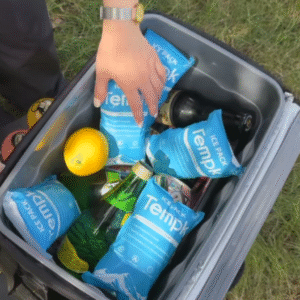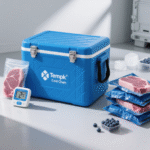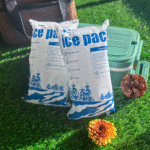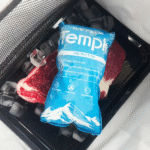How to Effectively Use Cooler Dry Ice Packs for Safe Shipping?
Ensuring temperature-sensitive goods stay in optimal condition during transit is critical for businesses that handle perishable items. Cooler dry ice packs are an essential part of the solution, keeping goods frozen or chilled during shipping. In diesem umfassenden Leitfaden, we’ll explore the best practices for using dry ice packs in coolers and answer your key questions to make sure your shipments are safe, kostengünstig, und effizient.
-
What are cooler dry ice packs, and why are they important for shipping?
-
How do you choose the right dry ice pack for your shipments?
-
What are the safety precautions when using dry ice?
-
How to handle and store dry ice safely?
What are Cooler Dry Ice Packs, and Why Are They Important?
Cooler dry ice packs are critical for transporting products that need to stay frozen, wie Pharmazeutika, Essen, und biologische Proben. Dry ice sublimates at -78.5°C, providing a highly effective cooling solution without leaving any liquid residue, which is perfect for long-distance shipping.
The key benefit of using dry ice is its ability to maintain an ultra-cold environment, which ensures that temperature-sensitive goods remain in their optimal state. Zum Beispiel, dry ice helps prevent spoilage in frozen food products or preserves the effectiveness of vaccines during transit.
Characteristics of Dry Ice Packs
| Characteristics | Beschreibung | What It Means for You |
|---|---|---|
| Temperaturbereich | -78.5°C | Keeps items frozen or chilled during transit |
| Sublimationsrate | 5-10 lbs pro 24 Std. | Impacts the frequency of pack replacement |
| Versandvorschriften | Subject to DOT and IATA rules | Avoids delays and ensures safe transport |
How Do You Choose the Right Cooler Dry Ice Pack for Shipping?
Selecting the right cooler dry ice pack depends on several factors, including the type of product being shipped and the duration of the shipment. Für Kurztrips, smaller packs may suffice, but for longer shipments, you will need larger packs or multiple smaller ones.
Key Factors for Choosing Dry Ice Packs:
-
Versandtyp: Für gefrorene Waren (Z.B., ice cream or meat), dry ice is your best option. Für gekühlte Gegenstände (Z.B., fresh vegetables or pharmaceuticals), ice packs or gel packs are more suitable.
-
Versanddauer: Longer trips require more dry ice or better insulation to maintain consistent temperatures.
Practical Tips:
-
Für Lebensmittelprodukte, use dry ice with insulated containers to ensure the cold lasts through longer transit.
-
Für Pharmazeutische Sendungen, opt for larger dry ice packs or multiple smaller ones to guarantee temperature consistency.
-
Für Biologische Proben, ensure that dry ice packs meet required temperature thresholds to preserve the integrity of the samples.
Safety Precautions When Using Dry Ice
Handling dry ice requires special precautions to avoid injuries such as frostbite or asphyxiation due to CO₂ buildup.
Safety Guidelines:
-
Belüftung: Always use dry ice in well-ventilated areas. Wie es sublimiert, Es veröffentlicht Co₂ -Gas, which can be dangerous in enclosed spaces.
-
Schutzausrüstung: Wear insulated gloves and goggles when handling dry ice.
-
Entsorgung: Let unused dry ice sublimate in a well-ventilated area, away from people and pets.
| Speicherrichtlinien | Beschreibung | Your Action |
|---|---|---|
| Ventilated Area | Avoid enclosed spaces | Ensure proper airflow in storage |
| Schutzausrüstung | Use gloves and goggles | Protect yourself from frostbite |
| Disposal Methods | Let dry ice sublimate in open air | Safely dispose in outdoor spaces |
2025 Trends and Developments in Dry Ice Shipping
Die Kaltkette -Logistikindustrie entwickelt sich schnell weiter, with new technologies emerging to improve efficiency, Sicherheit, and sustainability in temperature-sensitive shipping.
Schlüsseltrends:
-
Smart Temperature Sensors: These devices monitor and alert you to temperature fluctuations during shipping.
-
Blockchain -Technologie: Used for traceability and enhancing supply chain security.
-
Nachhaltige Materialien: Innovations like biodegradable gel packs and phase-change materials (PCMs) gewinnen an Traktion.
Markteinsichten:
Da die Nachfrage nach frischen, perishable products continues to rise, the cold chain market is expected to surpass $500 Milliarden von 2025. This growth is largely driven by sectors like food delivery, Arzneimittel, und E-Commerce, making efficient dry ice solutions even more essential for businesses.
Häufig gestellte Fragen
Q1: Wie lange dauert Trockeneis im Transport??
Trockeneis dauert normalerweise dazwischen 24-48 Std., depending on the size of the pack, Isolationsqualität, und externe Temperatur.
Q2: Can I use dry ice for international shipments?
Ja, but dry ice is classified as a hazardous material. Be sure to follow all international shipping regulations and consult with your carrier for any specific rules.
Q3: How should I pack dry ice?
Always use well-insulated containers and ensure that there is proper ventilation to allow sublimation. Label your packages accordingly to indicate that they contain dry ice.
Schlussfolgerung und Empfehlungen
To successfully ship temperature-sensitive goods, selecting the appropriate cooler dry ice pack is essential. By considering your shipment’s needs, choosing the right size, and following safety protocols, you can ensure that your products arrive in perfect condition.
Nächste Schritte:
-
Bewerten Sie Ihre Versandanforderungen and choose the appropriate dry ice packs for your products.
-
Train your staff on safe handling procedures to reduce risks associated with dry ice.
-
Bleib informiert about emerging trends in cold chain logistics to optimize your shipping process.
Über Tempk
Und Tempk, we specialize in providing high-quality dry ice solutions tailored to meet the unique needs of your business. With extensive experience in cold chain logistics, we ensure that your shipments remain safe and efficient throughout transit.
Aufruf zum Handeln:
Contact us today for expert advice on dry ice shipping solutions or to place an order for your next shipment.
























